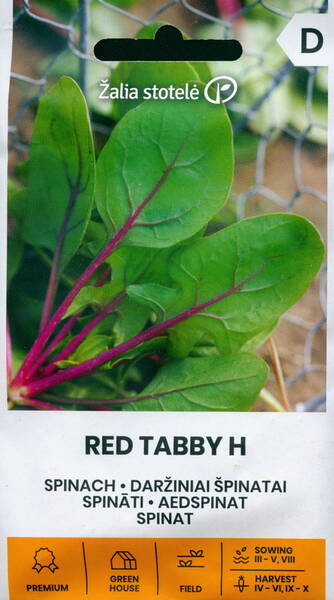Early hybrid resistant to cucurbit mildew. Cultivated for early spring and autumn harvest.
Vegetation period is 30-40 days from sowing. Leaves are thin, green with reddish veins, pink stem.
Sown in March or September, more densely than other varieties. Used fresh, good for processing.
Spinach leaves are valuable for vitamins, minerals and other nutrients necessary for the body.
1,0 g = 100 seeds.
* The birthplace of spinach is Asia (Ancient Persia, modern Iran). From there, two centuries BC. was brought to China. However, spinach was predominantly bred in Asian countries and was very popular with the Arabs. There is no information about the cultivation of spinach by the ancient Greeks or Romans ...
Spinach leaves are very rich in proteins (34%) and carbohydrates, contain a large number of vitamins C (37-72 mg / 100g), B1, B2, carotene (up to 4 mg / 100g), as well as iron and phosphorus salts. In addition, spinach contains vitamins K, P, E and salts of potassium, calcium, magnesium and iodine. Currently, spinach, as an unpretentious early green, is widely grown in the countries of America and Western Europe, as well as in China and Japan.
Young spinach leaves are consumed both raw and boiled or stewed, and, of course, canned.
The most useful, which is logical, are fresh leaves in their raw form (they are quite well stored at a temperature of +1 + 2 degrees Celsius and do not deteriorate for up to 3 months), salads are prepared from them, and juice is squeezed out.
The most common spinach dishes are soups, mashed potatoes, and in Russia - green cabbage soup.
Spinach juice is a very useful dietary product. Washed spinach spoils quickly, so it should be washed immediately before use. Spinach is boiled in salted water for 7-10 minutes. In order for spinach to retain its colour during cooking, it should be boiled in an open container in a large amount of water (3-4 litres per 1 kg of spinach) at a rapid boil.
You can not stew spinach with sorrel, as the spinach changes colour and coarsens.
Spinach juice is a good natural dye: it gives dishes a rich green colour.
* Spinach is a storehouse of vitamins!
A very valuable vegetable annual plant.
It is characterized by a high content of minerals, protein, vitamins.
Spinach contains a large amount of nutrients valuable for the human body. Its leaves contain vitamins C, A, B1, B2, B6, E, D2, PP, P, as well as proteins, phosphorus, calcium and iron salts. In terms of the amount and content of vitamins, spinach significantly surpasses other green and spicy-flavored crops.
Spinach greens have a high dietary value. Its introduction into the diet prevents and cures many diseases of the stomach. Due to its high iron content, spinach is used in the treatment of certain blood disorders.
Spinach is a cold-resistant crop, sown in open ground at the earliest dates, in late April - early May, to a depth of 1.5-2 cm. The culture is demanding on soil fertility and moisture. High temperatures cause shooing, while short days delay leaf development. Therefore, the most optimal sowing is in May - early June. Seeding rate 3-4 g / m2, planting depth 2-3 cm. Row spacing 25-30 cm. Distance between plants after thinning (in the phase of two true leaves) -10 cm.
Harvesting is carried out selectively, repeatedly, before flowering. High summer temperatures force the plant to follow the arrow, so we recommend re-sowing only at the beginning of August (in Estonian climate zone).
Culture is demanding on moisture and soil fertility.
* What are the requirements for growing conditions for spinach?
Spinach is a short-day plant, cold-resistant, undemanding, but prefers moist, fertile soils with a neutral reaction and good lighting.
In Estonia, it is best sown in the second half of summer, when it produces a lot of greenery.
When sown in spring, the plant forms small leaves, blooms quickly due to white nights and hot weather.
In other regions, it can be sown directly into the ground from early spring every 2 weeks and receive young green mass all summer.
This is one of the earliest maturing green plants - spinach is ready for consumption after 25 days of germination.
The required feeding area is 7 x 15 cm, so it is rarely sown immediately.















